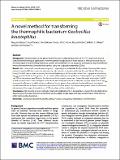Por favor, use este identificador para citar o enlazar a este item:
http://hdl.handle.net/10261/168855COMPARTIR / EXPORTAR:
 SHARE SHARE
 CORE
BASE CORE
BASE
|
|
| Visualizar otros formatos: MARC | Dublin Core | RDF | ORE | MODS | METS | DIDL | DATACITE | |

| Campo DC | Valor | Lengua/Idioma |
|---|---|---|
| dc.contributor.author | Miyano, Megumi | - |
| dc.contributor.author | Tanaka, Kosei | - |
| dc.contributor.author | Ishikawa, Shu | - |
| dc.contributor.author | Mori, Kotaro | - |
| dc.contributor.author | Miguel-Arribas, Andrés | - |
| dc.contributor.author | Meijer, Wilfried J. J. | - |
| dc.contributor.author | Yoshida, Ken-ichi | - |
| dc.date.accessioned | 2018-08-19T03:25:12Z | - |
| dc.date.available | 2018-08-19T03:25:12Z | - |
| dc.date.issued | 2018-08-17 | - |
| dc.identifier.citation | Microbial Cell Factories 17: 127 (2018) | - |
| dc.identifier.uri | http://hdl.handle.net/10261/168855 | - |
| dc.description.abstract | [Background] Bacterial strains of the genus Geobacillus grow at high temperatures of 50–75 °C and could thus be useful for biotechnological applications. However, genetic manipulation of these species is difficult because the current techniques for transforming Geobacillus species are not efficient. In this study, we developed an easy and efficient method for transforming Geobacillus kaustophilus using the conjugative plasmid pLS20cat. [Results] We constructed a transformation system comprising (i) a mobilizable Bacillus subtilis–G. kaustophilus shuttle plasmid named pGK1 that carries the elements for selection and replication in Geobacillus, and (ii) a pLS20cat-harboring B. subtilis donor strain expressing the dam methylase gene of Escherichia coli and the conjugation-stimulating rapLS20 gene of pLS20cat. This system can be used to efficiently introduce pGK1 into G. kaustophilus by mobilization in a pLS20cat-dependent way. Whereas the thermostable kanamycin marker and Geobacillus replication origin of pGK1 as well as expression of dam methylase in the donor were indispensable for mobilization, ectopic expression of rapLS20 increased its efficiency. In addition, the conditions of the recipient influenced mobilization efficiency: the highest mobilization efficiencies were obtained using recipient cells that were in the exponential growth phase. Furthermore, elimination of the origin of transfer from pLS20cat enhanced the mobilization. [Conclusions] We describe a novel method of plasmid mobilization into G. kaustophilus recipient from B. subtilis donor depending on the helper function of pLS20cat, which enables simple, rapid, and easy transformation of the thermophilic Gram-positive bacterium. | - |
| dc.description.sponsorship | This work was supported by the Ministry of Education, Culture, Sports, Science and Technology, Japan, and in part by Special Coordination Funds for Promot‑ ing Science and Technology from JST (Creation of Innovative Centers for Advanced Interdisciplinary Research Areas), Open Partnership Joint Research Projects/Seminars from JSPS to KY, and KAKENHI from JSPS 17K19237 and 18H02128 to KY. The Ministry of Economy and Competitiveness of the Spanish Government supported this work by research projects Bio2013-41489-P and BIO2016-77883-C2-1-P to WM which also supported AM-A. | - |
| dc.publisher | BioMed Central | - |
| dc.relation | info:eu-repo/grantAgreement/MINECO/Plan Estatal de Investigación Científica y Técnica y de Innovación 2013-2016/Bio2013-41489-P | - |
| dc.relation | info:eu-repo/grantAgreement/MINECO/Plan Estatal de Investigación Científica y Técnica y de Innovación 2013-2016/BIO2016-77883-C2-1-P | - |
| dc.relation.isversionof | Publisher's version | - |
| dc.rights | openAccess | - |
| dc.subject | Geobacillus kaustophilus | - |
| dc.subject | Bacillus subtilis | - |
| dc.subject | Plasmids | - |
| dc.subject | Mobilization | - |
| dc.subject | Transformation | - |
| dc.subject | Conjugation | - |
| dc.title | A novel method for transforming the thermophilic bacterium Geobacillus kaustophilus | - |
| dc.type | artículo | - |
| dc.identifier.doi | 10.1186/s12934-018-0969-9 | - |
| dc.description.peerreviewed | Peer reviewed | - |
| dc.relation.publisherversion | https://doi.org/10.1186/s12934-018-0969-9 | - |
| dc.identifier.e-issn | 1475-2859 | - |
| dc.date.updated | 2018-08-19T03:25:12Z | - |
| dc.language.rfc3066 | en | - |
| dc.rights.license | http://creativecommons.org/licenses/by/4.0/ | - |
| dc.contributor.funder | Ministry of Education, Culture, Sports, Science and Technology (Japan) | - |
| dc.contributor.funder | Ministerio de Economía, Industria y Competitividad (España) | - |
| dc.relation.csic | Sí | - |
| dc.identifier.funder | http://dx.doi.org/10.13039/501100001700 | es_ES |
| dc.identifier.funder | http://dx.doi.org/10.13039/501100010198 | es_ES |
| dc.identifier.pmid | 30119674 | - |
| dc.type.coar | http://purl.org/coar/resource_type/c_6501 | es_ES |
| item.openairetype | artículo | - |
| item.grantfulltext | open | - |
| item.cerifentitytype | Publications | - |
| item.openairecristype | http://purl.org/coar/resource_type/c_18cf | - |
| item.fulltext | With Fulltext | - |
| Aparece en las colecciones: | (CBM) Artículos | |
Ficheros en este ítem:
| Fichero | Descripción | Tamaño | Formato | |
|---|---|---|---|---|
| 12934_2018_Article_969.pdf | 1,22 MB | Adobe PDF |  Visualizar/Abrir |
CORE Recommender
PubMed Central
Citations
1
checked on 02-abr-2024
SCOPUSTM
Citations
4
checked on 18-abr-2024
WEB OF SCIENCETM
Citations
2
checked on 26-feb-2024
Page view(s)
374
checked on 18-abr-2024
Download(s)
227
checked on 18-abr-2024

